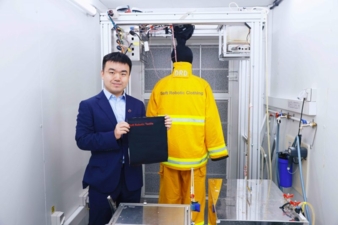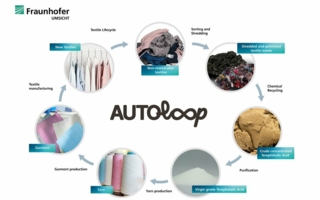26/08/2024 – Protective clothing
Intelligent robotic clothing for automatic thermal adaptation
PolyU researchers have developed first-of-its-kind thermally-insulated and breathable soft robotic clothing that can automatically adapt to changing ambient temperatures, thereby helping to ensure worker safety in hot environments.
Thermal protective clothing is essential to safeguard individuals in extreme high-temperature environments, such as firefighters who need to be present at fires scenes and construction workers who work outdoors for extended periods. However, traditional gear has been limited by statically fixed thermal resistance, which can lead to overheating and discomfort in moderate conditions, while its heat insulation may not offer sufficient protection in extreme fire events and other high-temperature environments. To address this issue, a team led by Dr Dahua SHOU, Limin Endowed Young Scholar in Advanced Textiles Technologies and Associate Professor of the School of Fashion and Textiles of The Hong Kong Polytechnic University (PolyU) has developed intelligent soft robotic clothing for automatic temperature adaptation and thermal insulation in hot environments, offering superior personal protection and thermal comfort across a range of temperatures.
Inspired by nature
Their research was inspired by biomimicry in nature, like the adaptive thermal regulation mechanism in pigeons, which is mainly based on structural changes. Pigeons use their feathers to trap a layer of air surrounding their skin to reduce heat loss to the environment. When the temperature drops, they fluff up their feathers to trap a significant amount of still air, thereby increasing thermal resistance and retaining warmth.
The protective clothing developed by the team uses soft robotic textile for dynamic adaptive thermal management. Soft actuators, designed like a human network-patterned exoskeleton and encapsulating a non-toxic, non-flammable, low-boiling-point fluid, were strategically embedded within the clothing. This thermo-stimulated system turns the fluid from a liquid into a gas when the ambient temperature rises, causing expansion of soft actuators and thickening the textile matrix, thereby enhancing the gap of still air and doubling the thermal resistance from 0.23 to 0.48 Km²/W. The protective clothing can also keep the inner surface temperatures at least 10°C cooler than conventional heat-resistant clothing, even when the outer surface reaches 120°C.
Also applicable for sudden temperature drops
This unique soft robotic textile, made by thermoplastic polyurethane, is soft, resilient and durable. Notably, it is far more skin-friendly and conformable than temperature-responsive clothing embedded with shape-memory alloys and is adjustable for a wide range of protective clothing. The soft actuators have exhibited no signs of leakage after undergoing rigorous standard washing tests. The porous, spaced knitting structure of the material can also significantly reduce convective heat transfer while maintaining high moisture breathability. Not relying on thermoelectric chips or circulatory liquid cooling systems for cooling or heat conduction, the light-weighted, soft robotic clothing can effectively regulate temperature itself without any energy consumption.
Supported by the Innovation and Technology Commission and the Hong Kong Research Institute of Textiles and Apparel, Dr Shou and his team have also extended the thermo-adaptive concept to develop inflatable, breathable jackets and warm clothing. This soft robotic clothing is suitable for low-temperature environments or sudden temperature drops to aid those who are stranded in the wilderness to maintain normal body temperature.




